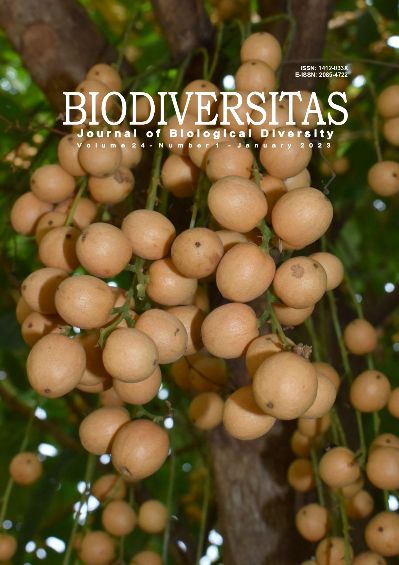Molecular and morphological characterization of fungi isolated from nutmeg (Myristica fragrans) in North Sulawesi, Indonesia
##plugins.themes.bootstrap3.article.main##
Abstract
Abstract. Arifah F, Aini LQ, Muhibuddin A. 2023. Molecular and morphological characterization of fungi isolated from nutmeg (Myristica fragrans) in North Sulawesi, Indonesia. Biodiversitas 24: 441-453. Nutmeg (Myristica fragrans Houtt) is one of the predominant commodities from Indonesia exported to the EU market. However, it is frequently rejected due to mycotoxin (especially aflatoxin) content exceeding the aflatoxin standard set by the EU. The high levels of aflatoxin were hypothesized to be produced by a toxigenic fungus infecting nutmeg during and after harvest. The study aims to determine and identify fungal contaminants in nutmeg kernels and provide information on the types of mycotoxins produced. Ten fungal morphotypes were isolated from nutmeg kernels collected from North Minahasa, North Sulawesi, Indonesia, and were grouped into four genera (Aspergillus, Lasiodiplodia, Rhizopus, and Penicillium) based on morphological characters. Ten fungal morphotypes were identified, i.e., Aspergillus flavus (Groups I and II), A. tamarii (Groups I and II), A. niger, A. aculeatus, A. ochraceus, Lasiodiplodia sp., Rhizopus delemar, and Penicillium sp. Isolates of A. flavus and A. tamarii were divided into two groups based on slight differences in their colony appearances. Molecular identification using homology of 18S rDNA sequences and ITS regions supports morphological identification except for isolates of A. flavus (Groups I and II), Lasiodiplodia sp., and Penicillium sp. These isolates were identified as A. nomiae and A. aflatoxiformans (A. autswikcii), L. theobromae, and P. citrinum. The maximum likelihood phylogenetic tree showed that isolates from the same species were grouped in the same clade. The L. theobromae was the most dominant type of fungus in the nutmeg kernels (55.61%), followed by A. niger (23.8%) and A. tamarii (10.53%). It is the first report of A. aflatoxiformans or A. autswikcii in nutmeg kernels, and no incidence of L. theobromae in nutmeg kernels from Indonesia previously.
##plugins.themes.bootstrap3.article.details##
Most read articles by the same author(s)
- MOCHAMMAD SYAMSUL HADI, ABDUL LATIEF ABADI, TOTO HIMAWAN, MASRURI, SAFIRA RIZKA LESTARI, BAMBANG TRI RAHARDJO, LUQMAN QURATA AINI, YOGO SETIAWAN, HAGUS TARNO, The role of bacterial symbionts in the biodegradation of chlorpyrifos in the digestive tract of Plutella xylostella larvae , Biodiversitas Journal of Biological Diversity: Vol. 22 No. 2 (2021)
- NOVIA DWI PUTRI, LILIEK SULISTYOWATI, LUQMAN QURATA AINI, ANTON MUHIBUDDIN, IRISA TRIANTI, Screening of endophytic fungi as potential antagonistic agents of Pyricularia oryzae and evaluation of their ability in producing hydrolytic enzymes , Biodiversitas Journal of Biological Diversity: Vol. 23 No. 2 (2022)
- NURHALIMAH, ANTON MUHIBUDDIN, MUHAMMAD AKHID SYIB’LI , Screening of yeast isolates for the biocontrol of Sclerotium rolfsii , Biodiversitas Journal of Biological Diversity: Vol. 23 No. 7 (2022)
- TITA WIDJAYANTI, RESTU RIZKYTA KUSUMA, LUQMAN QURATA AINI, CINDY DIAH AYU FITRIANI, ANTOK WAHYU SEKTIONO, MOCHAMMAD SYAMSUL HADI, YOGO SETIAWAN, Screening of phyllospheric and endophytic bacteria as biocontrol agents of Xanthomonas oryzae pv. oryzae , Biodiversitas Journal of Biological Diversity: Vol. 24 No. 4 (2023)
- LUQMAN QURATA AINI, IRISA TRIANTI, SHOLIKAH WIDYANITTA RACHMAWATI, ANTON MEILUS PUTRA, NABILLA ALYA ANASTASYA, ADI SETIAWAN, In vitro characterization of UB Forest (Malang, Indonesia) indigenous bacteria as plant growth promoting bacteria (PGPB) , Biodiversitas Journal of Biological Diversity: Vol. 24 No. 8 (2023)
- RIDA ISWATI, LUQMAN QURATA AINI, SOEMARNO, ABDUL LATIEF ABADI, Exploration and characterization of indigenous Trichoderma spp. as antagonist of Rhizoctonia solani and plant growth promoter of maize , Biodiversitas Journal of Biological Diversity: Vol. 25 No. 4 (2024)
- NABILLA ALYA ANASTASYA, ANTON MEILUS PUTRA, SHOLIKAH WIDYANITTA RACHMAWATI, IRISA TRIANTI, ADI SETIAWAN, ABDUL LATIEF ABADI, LUQMAN QURATA AINI, Impact of plant growth-promoting bacteria on the growth performance and resistance enzymes of tatsoi mustard in a hydroponic system , Biodiversitas Journal of Biological Diversity: Vol. 25 No. 8 (2024)

